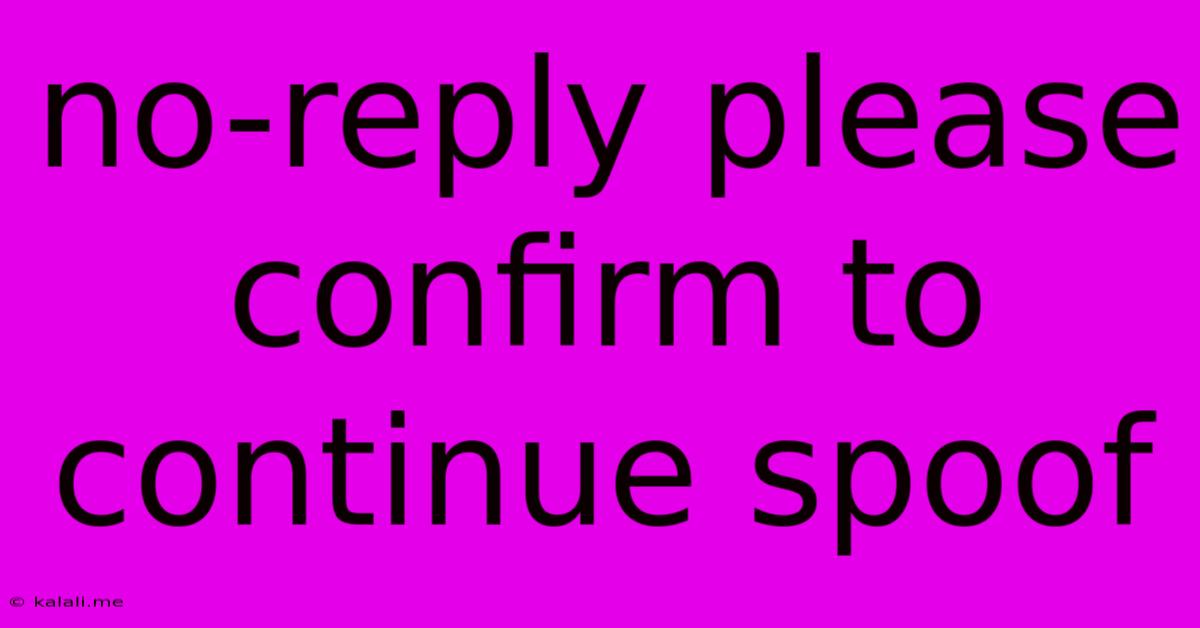No-reply Please Confirm To Continue Spoof
Kalali
May 23, 2025 · 3 min read

Table of Contents
Decoding the "No-Reply: Please Confirm to Continue" Spoof Email
The seemingly innocuous subject line, "No-Reply: Please Confirm to Continue," is often a red flag signaling a phishing attempt or a sophisticated email spoofing scam. This article delves into the techniques used in these scams, how they work, and most importantly, how to protect yourself from falling victim. Understanding these tactics is crucial in today's increasingly digital world.
Understanding the Spoofing Technique
The core of this scam relies on social engineering and deceptive email practices. The "No-Reply" address creates a sense of legitimacy, suggesting an automated system is sending the message. This is designed to discourage a reply, diverting your attention from the suspicious nature of the email. The "Please Confirm to Continue" phrase urges immediate action, leveraging a sense of urgency to pressure the recipient into clicking a malicious link or downloading an infected attachment.
How the Scam Works
These spoof emails often mimic legitimate services you use regularly, such as:
- Online Banking: These spoofs might ask you to confirm your login details, update your account information, or verify a recent transaction. They usually direct you to a fake website that looks identical to your bank's website.
- E-commerce Platforms: Similar to banking scams, they might claim a problem with your order, request confirmation of a recent purchase, or ask for payment details.
- Social Media Accounts: These emails might warn about suspicious activity on your account, requiring you to click a link to secure it.
- Email Providers: These attempts typically claim an issue with your email account, prompting you to update your password or verify your identity.
Identifying the Red Flags
Several key indicators can help you identify these spoof emails:
- Generic Greetings: The email may address you with a generic greeting like "Dear Customer" or "Valued User" instead of your name.
- Suspicious Links: Hover your mouse over any links before clicking to reveal their actual destination. Legitimate links will match the sender's domain.
- Grammar and Spelling Errors: Poor grammar and spelling are common giveaways of fraudulent emails.
- Sense of Urgency: The email creates a sense of urgency, pressuring you to act quickly without thinking.
- Threats: The email might threaten account suspension or other negative consequences if you don't act immediately.
- Unexpected Emails: Be wary of emails you weren't expecting, especially those asking for personal information.
Protecting Yourself from Spoofing Attacks
- Verify the Sender: Before clicking any links or opening any attachments, independently verify the sender's identity through official channels.
- Don't Click Suspicious Links: Never click links in emails you're unsure about. Instead, type the website address directly into your browser.
- Check for HTTPS: Ensure that the website you're visiting uses HTTPS, indicated by a padlock icon in the address bar.
- Keep Software Updated: Regularly update your operating system and antivirus software to protect against malware.
- Be Wary of Urgent Requests: Legitimate organizations rarely demand immediate action.
- Enable Two-Factor Authentication: This adds an extra layer of security to your accounts.
- Educate Yourself and Others: Staying informed about the latest phishing techniques is crucial in protecting yourself and others.
By understanding the techniques used in these spoofing attacks and implementing the preventative measures outlined above, you can significantly reduce your risk of becoming a victim. Remember, caution and awareness are your best defenses against these increasingly sophisticated scams.
Latest Posts
Latest Posts
-
How To Cut Off Table Legs Evenly
May 23, 2025
-
Nano Go To End Of File
May 23, 2025
-
Gui From Root Command Line Linux
May 23, 2025
-
It Was A Pleasure To Meet You
May 23, 2025
-
Tar Removing Leading From Member Names
May 23, 2025
Related Post
Thank you for visiting our website which covers about No-reply Please Confirm To Continue Spoof . We hope the information provided has been useful to you. Feel free to contact us if you have any questions or need further assistance. See you next time and don't miss to bookmark.